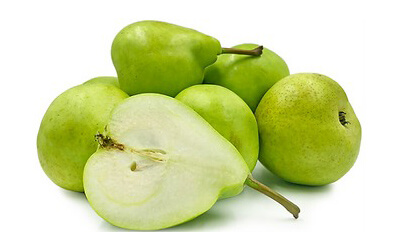PACKHAM PEAR
Packham pears are a cross between two English pears, a williams’ bon chrétien, more commonly known as a bartlett.

Packham pears are medium to large in size and are irregular in shape with a bulbous, wide bottom that tapers to a smaller rounded neck with a slender, dark brown stem. Similar in appearance to a bartlett pear, the skin transforms from green to pale yellow when ripe and is covered in patches of russeting, prominent lenticels, and small, smooth bumps. The flesh is white to ivory and is fine-grained, moist, and soft encasing a central core with a few, black-brown seeds. When ripe, Packham pears are juicy and creamy with a sweet, aromatic flavor.
CORELLA PEARS
The first Corella pears were grown in the Barossa Valley in southern Australia by German settlers during the late 19th century. Today they are grown predominately in Australia and can also be found in Asia and Europe at farmers markets and specialty grocers.

Corella pears are small to medium in size and are irregular in shape ranging from oblong to squat with a large base that tapers to a smaller, rounded neck. The smooth skin has a mixture of green and yellow hues with some red blushing and prominent lenticels. The ivory to pale white flesh is creamy, moist, and crisp, encasing a few small black-brown seeds inside of a central core connecting to a dark brown stem. Corella pears can be consumed when firm and crunchy or can be left to ripen fully and consumed when soft and creamy. They are aromatic with a fresh, green scent and are very juicy with a sweet, mild flavor.


